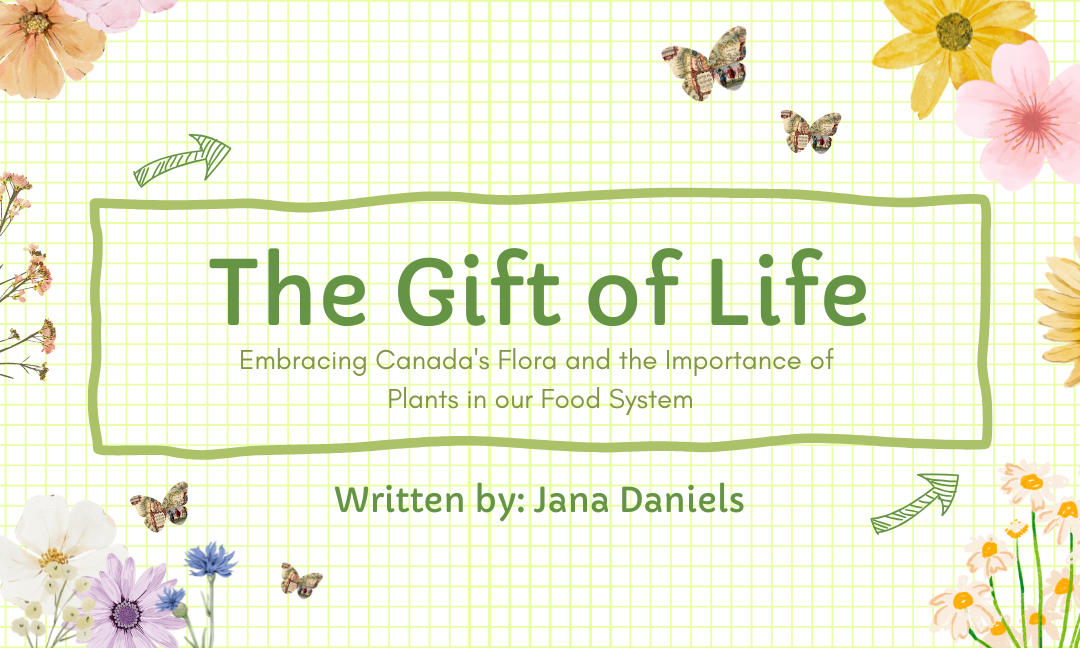Written by: Jana Daniels
Edited by: Nicole Majewski
Designed by: Sunnie Huang
Published by: Rayna Almas
Around this time of year, many people think of gifts. Today, I want to talk about “the gift of life”. What comes to mind when you hear that phrase? Perhaps you think of your family, pets, or even wholesome interactions with other humans. These are all amazing things, and such great gifts in life. Hopefully, I can help you see that the gift of life actually entails much more than these examples. And when you hear the phrase “the gift of life” hereafter, you’ll think of how our (inter)connectedness is the true gift of life. This (inter)connectedness starts with our flora.

Did you know that as of 2020, there were 768 plant species listed as “imperiled” or “critically imperiled” and 486 plants listed as “invasive plant species” in Canada?
“Flora” refers to all the plants found in a specific region. Canada is so blessed by such rich flora. Canada is home to 6730 plants, with 5341 of these plants being native to Canada. Isn’t that amazing?
Plants are critical to all life. They provide oxygen, food, and wildlife habitat. They regulate the climate, create soil, improve air and water quality, and reduce erosion. What would we do without plants?
Plants play such an important role in our lives. The role I’m going to zero in on is how they provide food for us. It may seem obvious that plants provide food for us. After all, we do eat fruits and vegetables. Those are plants. Something you may not think of as often, is how plants are an important component to our food web.
Food webs. Many of us learned about food webs back in elementary school. Food webs are visuals, showing how fungi, plants, animals, and humans are all connected, and how they rely on one another. I think that they are so cool, because they really allow us to appreciate every tiny part that allows us to live this gift we call “life”.
A simplified version of food webs that we learned about earlier in elementary school are called food chains. Food chains are like a hierarchy showing energy transfer from lower levels to higher levels on the food chain. The “lowest level” on many food chains are plants (or fungi).
Food chains start with plants, and couldn’t survive without plants. The herbivores and omnivores need plants. If there weren’t plants, some omnivores would die, which would, in turn, kill other omnivores and carnivores. If that happened, humans would have no food. If humans have no food, they wouldn’t have energy to do anything. They wouldn’t be able to create tools and machines to help farmers, or make food in factories. If all the plants in the world suddenly went extinct, soon, we would too.

Fun fact: Did you know that humans are considered omnivores?
Plants are the foundation of this gift we call “life”. Since plants are so essential to human life, we should show more care and interest in our food systems, which start with plants.
We all have one chance, one life, to make a positive impact in this world. We can do this by using our different gifts, talents, and abilities. And YOU can make a difference. One area that I think you should consider making a difference in, is in the agriculture sector.
In Canada’s agriculture sector, for example, there are many problems that require our attention, such as:
- Endangered species
- Climate change
- Aging farmer population
- Inflation
Maybe, right now, there isn’t anything that you can do to directly impact one of these areas. However, even something as small as being more eco-friendly, going into the agriculture industry, or even writing a blog, sharing the importance of plants, can make a difference (see what I did there?).

Let’s make the most of the gift of life by remembering how important plants are this holiday season.
Happy Holidays!

Resources:
Photos:

